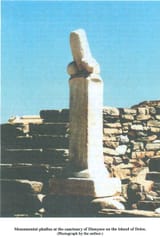Search Results
6/23/2025, 7:09:36 PM
>>508475895
In ancient Greece the cult of Dionysos was a phallic one, this is evidenced by temples, sculptures of phalli and descriptions of processions carrying huge phalli as late as the second century BC.
Brimming with virility, he was the god most favored by women.
The abundance of phalli in Dionysiac festivals, in sculptures near the temples, on herms used as signposts on the roads and before th e doors of houses suggest that the ancient Greeks were no less obsessed by cock magic than were the Old Europeans.
The Lenaia festival held in January was preceded by a Rural Dionysia in which phalli were carried in procession.
Broken stone phalli, representative of the god himself, can still be seen at the sanctuary of Dionysos, on the sacred island of Delos, to the mirth, embarrassment, and/or shock of visiting tourists.
But what is of greater importance is that the same Dionysos, still decked with ivy-sprays, was elsewhere represented by a post dressed up as the god. Dionysos represented an aspect of the Saturnian deity.
In ancient Greece the cult of Dionysos was a phallic one, this is evidenced by temples, sculptures of phalli and descriptions of processions carrying huge phalli as late as the second century BC.
Brimming with virility, he was the god most favored by women.
The abundance of phalli in Dionysiac festivals, in sculptures near the temples, on herms used as signposts on the roads and before th e doors of houses suggest that the ancient Greeks were no less obsessed by cock magic than were the Old Europeans.
The Lenaia festival held in January was preceded by a Rural Dionysia in which phalli were carried in procession.
Broken stone phalli, representative of the god himself, can still be seen at the sanctuary of Dionysos, on the sacred island of Delos, to the mirth, embarrassment, and/or shock of visiting tourists.
But what is of greater importance is that the same Dionysos, still decked with ivy-sprays, was elsewhere represented by a post dressed up as the god. Dionysos represented an aspect of the Saturnian deity.
Page 1
